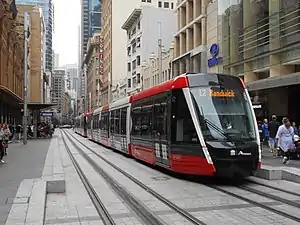Alstom APS
Alstom APS, also known as Alimentation par Sol or Alimentation Par le Sol (which literally means "feeding via the ground"), is a form of ground-level power supply for street trams and, potentially, other vehicles. APS was developed by Innorail, a subsidiary of Spie Enertrans, but was sold to Alstom when Spie was acquired by Amec. It was originally created for the Bordeaux tramway, which was constructed from 2000 and opened in 2003. From 2011, the technology has been used in a number of other cities around the world.[1]


APS is used, primarily for aesthetic reasons, as an alternative to overhead lines. As such, it competes with other ground-level power supply systems but also with energy storage systems such as batteries. In 2015, Alstom developed a derivative of APS, Alstom SRS (Système de Recharge statique par le sol or static-based ground charging system), which can be used to recharge battery powered trams and buses while they are stationary at stops.[2]
Alstom further developed the system for use by road vehicles such as semi-trailer trucks and cars. The electric road system has been tested for compatibility with snow plows and for safety under exposure to snow, ice, salting, and saturated brine.[3] France will trial the electric road system on a public road in the Rhône-Alpes region between 2024 and 2027.[4]
Technology
APS uses a third rail placed between the running rails that is divided electrically into 11 m segments that automatically switch on and off according to whether a tram is passing over them, thereby eliminating risk to other road users.[5] Each tram has two power collection shoes, next to which are antennas that send radio signals to energise the power rail segments as the tram passes over them. At any time, two consecutive segments under the tram will be live.
APS is different from the conduit current collection system, which was one of the first ways of supplying power to a tram system, as the latter involves burying a third and fourth rail in an underground conduit or trench between the running rails. Conduit current collection was used in historic tram systems in Washington, Manhattan, Paris, Berlin, Marseilles, Vienna, Budapest and London. It fell into disuse because overhead wires proved much less expensive and troublesome for street railways.[6]
Safety
Unlike the track-side third rail that is used by most metro trains and some main-line railways, APS poses no danger to people or animals and so can be used in pedestrian areas and city streets.[5] The French government reports no electrocutions or electrification accidents on any tramway in France from as early as 2003[7] until as recently as December 31, 2020.[7][8]
Uses
Bordeaux

Modern ground-level current collection was pioneered by the Bordeaux tramway in France. The public had assumed that the new system would use a traditional conduit system like that of the Bordeaux trams that had run prior to 1958 and objected when it learned that it was not considered safe and that overhead wires were to be used instead. Facing complaints both from the public and the French Ministry of Culture, planners developed APS as a modern way of replicating the conduit system.
There are 12 km (7.5 mi) of APS tramway in the three-line network of 43.3 km (26.9 mi) as of 2008. Bordeaux Alstom Citadis trams use pantographs and electric overhead lines in outlying areas.
Before use in Bordeaux, APS was tested and proved viable on a short section of reserved-track in the French city of Marseille. Nevertheless, Bordeaux has experienced problems, with APS being so temperamental that at one stage, the mayor issued an ultimatum that if reliability could not be guaranteed, it would have to be replaced with overhead wires.
Problems have included water-logging, when the water does not drain quickly enough after heavy rain.
Other cities

| System | City | Country | Opened | Comments |
|---|---|---|---|---|
| Angers tramway | Angers | France | 2011 | [9][10] |
| Reims tramway | Reims | France | 2011 | [9] |
| Orléans tramway | Orléans | France | 2012 | [11] |
| Tours tramway | Tours | France | 2013 | [12] |
| Dubai Tram | Dubai | United Arab Emirates | 2014 | The system is fully equipped with APS over its entire passenger route length and thus trams do not use their pantographs unless they are travelling within the depot area.[13] |
| VLT Carioca | Rio de Janeiro | Brazil | 2016 | The system mainly uses APS, but where that was deemed impractical, the trams employ Alstom's proprietary supercapacitor-based energy storage system.[14] |
| CBD and South East Light Rail | Sydney | Australia | 2019 | The system uses APS within the Sydney CBD and conventional overhead wires elsewhere.[15] |
| Cuenca tram | Cuenca | Ecuador | 2020 | The system uses APS in certain regions only and conventional overhead wires elsewhere.[16] |
| Istanbul T5 tramway | Istanbul | Turkey | 2021 | [17] |
| Lusail Tram | Lusail | Qatar | 2022 | The system uses APS on the above ground sections, with around 19 km of APS.[18] |
Standardization
Alstom, Elonroad, and other companies in 2020 began drafting a standard for ground-level power supply electric roads.[19][20] A working group of the French Ministry of Ecology considers rail ground-level power supply technology to be the most likely candidate for electric roads.[21] The first standard for electrical equipment on board a vehicle powered by a rail electric road system (ERS), CENELEC Technical Standard 50717, has been approved in late 2022.[22] The following standards, encompassing "full interoperability" and a "unified and interoperable solution" for ground-level power supply, are scheduled to be published by the end 2024, detailing complete "specifications for communication and power supply through conductive rails embedded in the road".[23][24]
References
- "Third-rail trams across the Garonne". Railway Gazette International. 2004-02-01. Retrieved 2008-05-02.
- "Alstom transfers tram power supply technology to buses". Rail Insider. 26 September 2019. Archived from the original on 29 November 2020. Retrieved 29 November 2020.
- Patrick Dupart (February 11, 2022), Compatibility of an in-road Electric Road System with winter service operations (PDF), Alstom, PIARC
- Jean-Philippe Pastre (June 30, 2023), "L'APS d'Alstom bientôt testé sur les routes", TRM24
- "APS: Service-proven catenary-free tramway operations". Alstom. Archived from the original on 2020-11-29. Retrieved 2020-11-29.
- Post, Robert C. (2007). Urban Mass Transit: The Life Story of a Technology. Greenwood Press. pp. 45–47. ISBN 978-0-313-33916-5.
- Service Technique des Remontées Mécaniques et des Transports Guidés - Division TramWays (November 2011), ACCIDENTOLOGIE DES TRAMWAYS - Analyse des évènements déclarés année 2010 - évolution 2003-2010 (PDF)
- Service Technique des Remontées Mécaniques et des Transports Guidés - Division TramWays (October 19, 2021), Accidentologie « tramways » – Données 2020 (PDF)
- "Reims and Angers choose APS". Railway Gazette International. 1 August 2006.
- "Angers tram opens". Railway Gazette International. 29 June 2011.
- Guerrieri, Marco (23 November 2019). "Catenary-Free Tramway Systems: Functional and Cost–Benefit Analysis for a Metropolitan Area". Urban Rail Transit. Springer Nature Switzerland AG. 5 (4): 289–309. doi:10.1007/s40864-019-00118-y. hdl:11572/246245. S2CID 208953068.
- "Tours selects Citadis and APS". Railway Gazette International. 2010-09-14. Archived from the original on 2012-09-25. Retrieved 2020-11-29.
- "Al Safouh tram project consortium selected". Railway Gazette International. 2008-04-29. Retrieved 2008-05-02.
- Wright, Sarah. "Alstom opens Rio's tramway ready for the 2016 Olympic Games". Retrieved 2017-11-04.
- "CBD and South East Light Rail improvements to deliver a better service for customers | Transport for NSW". Archived from the original on 2014-12-14. Retrieved 2014-12-02.
- UK, DVV Media. "First Cuenca tram on its way". Railway Gazette. Retrieved 2017-11-04.
- 2021-01-05T15:25:00. "Istanbul opens first section of Golden Horn tramway". Railway Gazette International. Retrieved 2021-08-09.
- "Lusail Tramway enters commercial service". Alstom. 10 January 2022. Retrieved 2022-12-03.
19 km of APS in at grade sections (ground power supply)
- PIARC (February 17, 2021), Electric Road Systems - PIARC Online Discussion, 34 minutes 34 seconds (standardization), 2 hours 36 minutes 51 seconds (standardization), archived from the original on 2021-12-22
- Martin G. H. Gustavsson, ed. (March 26, 2021), "Key Messages on Electric Roads - Executive Summary from the CollERS Project" (PDF), CollERS, p. 6, retrieved February 11, 2022
- Laurent Miguet (April 28, 2022), "Sur les routes de la mobilité électrique", Le Moniteur
- "PD CLC/TS 50717 Technical Requirements for Current Collectors for ground-level feeding system on road vehicles in operation", The British Standards Institution, 2022, archived from the original on January 2, 2023, retrieved January 2, 2023
- Final draft: Standardization request to CEN-CENELEC on ‘Alternative fuels infrastructure’ (AFI II) (PDF), European Commission, February 2, 2022, archived from the original (PDF) on April 8, 2022, retrieved January 2, 2023
- Matts Andersson (July 4, 2022), Regulating Electric Road Systems in Europe - How can a deployment of ERS be facilitated? (PDF), CollERS2 - Swedish German research collaboration on Electric Road Systems